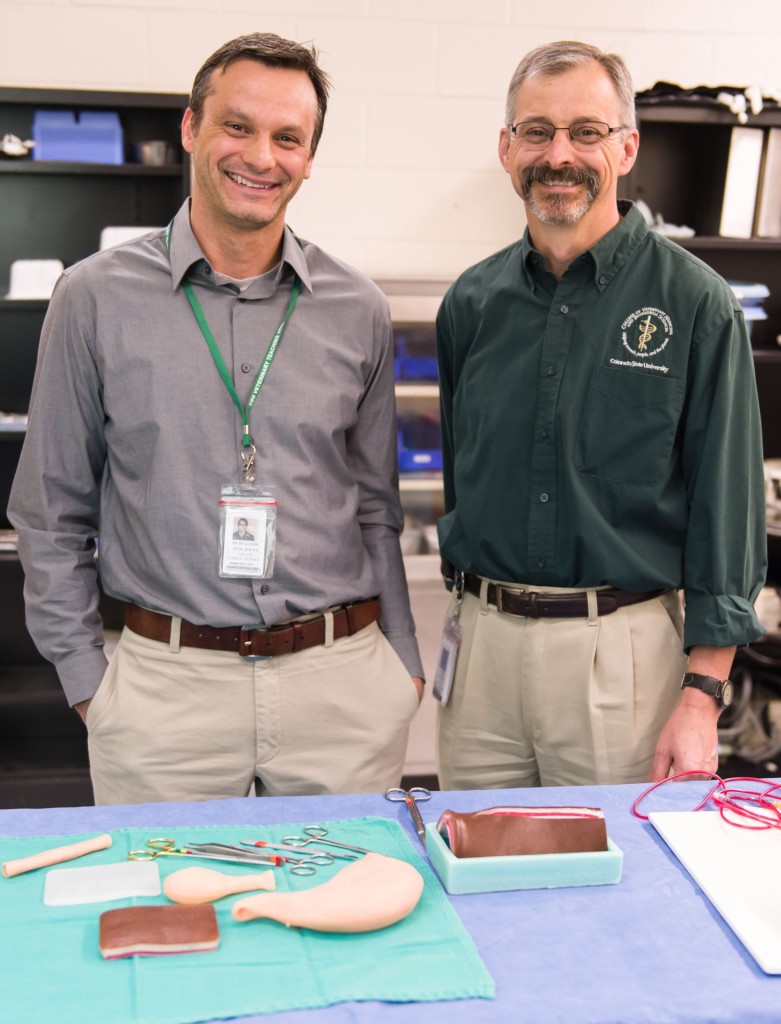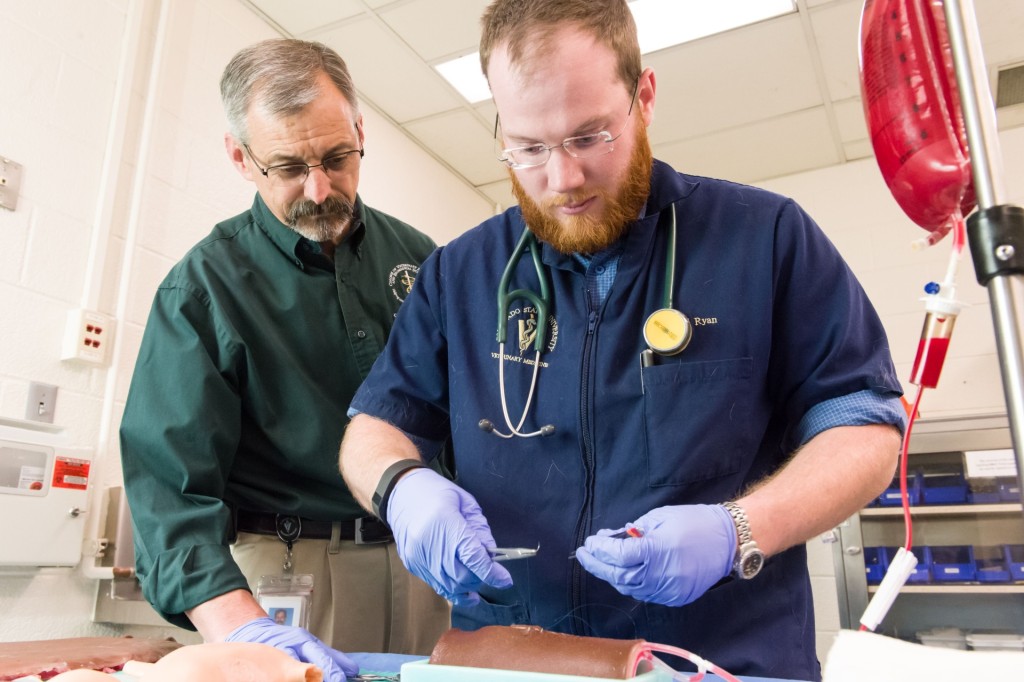Practicing surgical techniques on artificial skin that bleeds sure beats the alternative, Paul Ryan, a Colorado State University veterinary student, says. Before SurgiReal suture pads, his material of choice was “bananas, lots of bananas.”
Now, students at CSU and 140 other medical, nursing and veterinary schools nationwide train with patented SurgiReal body wall models developed by two Colorado State equine surgeons, Dr. Dean Hendrickson and Dr. Fausto Bellezzo.
SurgiReal products allow students to practice and refine surgical skills on realistic models instead of the old standbys – carpet scraps, orange peels and cadaver specimens, chiefly pigs’ feet. Unlike those crude substitutes, SurgiReal training models have multiple layers and exude fake blood.
Inventors Hendrickson and Bellezzo formed their startup in 2012 with help from CSU Ventures, an affiliate of the university that works with CSU faculty on technology transfer and commercialization. This spring, with business booming, the two veterinarians received the CSU Ventures Award for Innovative Excellence, a sign of success in moving technology to the marketplace.
“I think you could say the models are becoming a standard. The next generation of medical students will say, ‘We saw something where people used carpet pads – really?!’” Hendrickson says. “I had a donor say, ‘You’re turning the world upside-down with this,’ and I said, ‘No, I’m just trying to train surgeons.’”
Watch a veterinary student at work with a SurgiReal model, and it’s clear how these replicas help students prep for surgery on real patients.
Layer upon realistic layer

Ryan, a fourth-year vet student, cuts into a five-layer body wall – epidermis, subcutaneous fat, fascia, muscle, more fascia – and “blood” oozes from the incision. He clamps the tiny vessel with a hemostat and begins to tighten the suture.
“If you don’t tie it off well enough, it will continue to seep,” Ryan says, as he knots the suture and dabs at red liquid that flows from an attached IV bag. “These models are as close as I’ve ever seen to the real thing, honestly. It’s an incredible improvement over fruits and vegetables.”
Students studying veterinary and human medicine must learn how to cut through layers of skin, stanch blood, stitch up wounds and remove sutures.
To promote these basic skills, SurgiReal’s patented simulated tissue is constructed to feel like the real thing, with reinforced layers that tolerate the tension of suturing and other procedures. The RealLayer silicone pads can be re-used up to 10 times. And the RealFlow blood-vessel technology is designed to bleed when cut, or can be used without bleeding for training in tying and stapling. The “blood” is tinted powder mixed with water.
The Fort Collins company sells training kits complete with needles, scalpels and forceps, packaged with the simulated tissue in a notebook-style case so a student can practice anywhere. It also sells a variety of multi-layered suture pads, simulated small intestines, and realistic horse heads and dog legs.
Mad scientists? Maybe.
Hendrickson, a longtime CSU professor and equine surgeon, began to think about creating a better model in 1993, when he was at the University of Wisconsin. Inspired by movie effects, and impelled by a desire to better prepare students, Hendrickson thought, “Special effects in movies are so good. If they look that good, could you make something that also felt like the real tissues?”
He knew someone at Disney, who put him in touch with DuPont, which supplied silicone for movie special-effects. “We had just finished a surgery lab, and I remember thinking the students weren’t ready for the live-animal experience. We have to do better because the animals deserve that,” Hendrickson says.

He won a small grant and tinkered with the materials, but set aside the idea when he moved to Colorado and built an academic career. His ideas came to life in 2009, when he and Bellezzo started experimenting with silicones, molds, filaments and fake blood.
Did they feel a little like mad scientists? “Yes,” they both say, each pointing to the other and laughing. “It was truly monstrous,” Hendrickson says of an early horse model.
But in just three years, the startup has grown beyond the founders’ dreams – from molding body parts in a basement to a 2,100-square-foot manufacturing space.
Through CSU Ventures, Hendrickson and Bellezzo first patented their simulated skin and simulated organ technology. Now each holds four patents.
SurgiReal sales started in 2013, and revenue hit just over $280,000 last year. “We are on our way to $400,000 for 2015 – that’s our goal,” Hendrickson says.
Steve Foster, director of business development for CSU Ventures, admires the partners’ “willingness to think beyond themselves, and to be open to creating a new company to commercialize their work,” he says. “It will help students become better practitioners of veterinary and human medicine.”
Mary Jo Wiemiller, program director and chair of Marquette University Physician Assistant Studies, certainly thinks so. “SurgiReal provides an easy tool to practice on with a very realistic tension of human tissue,” says Wiemiller, a surgery instructor who uses SurgiReal suture pads in her classes.
“They are the most realistic product we’ve used to simulate human tissue – far superior to bananas, pigs’ feet or other products,” she says, adding that her students “appreciate the coloring separating the epidermis, dermis and hypodermis. They are in awe of how much harder it is to close the incisions without gaps.”
SurgiReal by the Numbers
- 6 years in the making
- 5 employees, with one contract salesperson
- 140+ veterinary, medical and nursing schools use SurgiReal products
- $99.99 Cost of reusable five-layer tissue pad with artificial bleeding